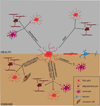NG2-glia and their functions in the central nervous system
- PMID: 26010717
- PMCID: PMC4470768
- DOI: 10.1002/glia.22859
NG2-glia and their functions in the central nervous system
Abstract
In the central nervous system, NG2-glia represent a neural cell population that is distinct from neurons, astrocytes, and oligodendrocytes. While in the past the main role ascribed to these cells was that of progenitors for oligodendrocytes, in the last years it has become more obvious that they have further functions in the brain. Here, we will discuss some of the most current and highly debated issues regarding NG2-glia: Do these cells represent a heterogeneous population? Can they give rise to different progenies, and does this change under pathological conditions? How do they respond to injury or pathology? What is the role of neurotransmitter signaling between neurons and NG2-glia? We will first give an overview on the developmental origin of NG2-glia, and then discuss whether their distinct properties in different brain regions are the result of environmental influences, or due to intrinsic differences. We will then review and discuss their in vitro differentiation potential and in vivo lineage under physiological and pathological conditions, together with their electrophysiological properties in distinct brain regions and at different developmental stages. Finally, we will focus on their potential to be used as therapeutic targets in demyelinating and neurodegenerative diseases. Therefore, this review article will highlight the importance of NG2-glia not only in the healthy, but also in the diseased brain.
Keywords: disease; heterogeneity; lineage potential; oligodendrocyte progenitors; physiology.
© 2015 Wiley Periodicals, Inc.
Figures



Similar articles
-
The heterogeneous nature of NG2-glia.Brain Res. 2016 May 1;1638(Pt B):129-137. doi: 10.1016/j.brainres.2015.09.012. Epub 2015 Sep 24. Brain Res. 2016. PMID: 26388262 Review.
-
Lineage, fate, and fate potential of NG2-glia.Brain Res. 2016 May 1;1638(Pt B):116-128. doi: 10.1016/j.brainres.2015.08.013. Epub 2015 Aug 21. Brain Res. 2016. PMID: 26301825 Free PMC article. Review.
-
NG2-glia, More Than Progenitor Cells.Adv Exp Med Biol. 2016;949:27-45. doi: 10.1007/978-3-319-40764-7_2. Adv Exp Med Biol. 2016. PMID: 27714683 Review.
-
Integration of NG2-glia (synantocytes) into the neuroglial network.Neuron Glia Biol. 2009 May;5(1-2):21-8. doi: 10.1017/S1740925X09990329. Epub 2009 Sep 29. Neuron Glia Biol. 2009. PMID: 19785922 Review.
-
[Biological characteristics and functions of NG2-glia].Sheng Li Xue Bao. 2021 Dec 25;73(6):940-952. Sheng Li Xue Bao. 2021. PMID: 34961869 Review. Chinese.
Cited by
-
Role of Glial Cells in Neuronal Function, Mood Disorders, and Drug Addiction.Brain Sci. 2024 May 30;14(6):558. doi: 10.3390/brainsci14060558. Brain Sci. 2024. PMID: 38928557 Free PMC article. Review.
-
Temporal dynamics of cells expressing NG2 and platelet-derived growth factor receptor-β in the fibrotic scar formation after 3-nitropropionic acid-induced acute brain injury.Cell Tissue Res. 2021 Sep;385(3):539-555. doi: 10.1007/s00441-021-03438-3. Epub 2021 Apr 17. Cell Tissue Res. 2021. PMID: 33864501
-
The relationships between neuroglial alterations and neuronal changes in Alzheimer's disease, and the related controversies I: Gliopathogenesis and glioprotection.J Cent Nerv Syst Dis. 2022 Oct 9;14:11795735221128703. doi: 10.1177/11795735221128703. eCollection 2022. J Cent Nerv Syst Dis. 2022. PMID: 36238130 Free PMC article. Review.
-
A view of the genetic and proteomic profile of extracellular matrix molecules in aging and stroke.Front Cell Neurosci. 2023 Nov 30;17:1296455. doi: 10.3389/fncel.2023.1296455. eCollection 2023. Front Cell Neurosci. 2023. PMID: 38107409 Free PMC article.
-
Voluntary wheel running promotes myelination in the motor cortex through Wnt signaling in mice.Mol Brain. 2019 Oct 24;12(1):85. doi: 10.1186/s13041-019-0506-8. Mol Brain. 2019. PMID: 31651333 Free PMC article.
References
-
- Aguirre A, Dupree JL, Mangin JM, Gallo V. A functional role for EGFR signaling in myelination and remyelination. Nat Neurosci. 2007;10(8):990–1002. - PubMed
Publication types
MeSH terms
Grants and funding
LinkOut - more resources
Full Text Sources
Other Literature Sources
Miscellaneous

